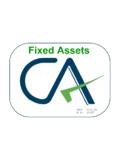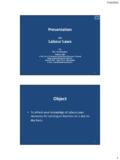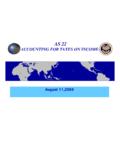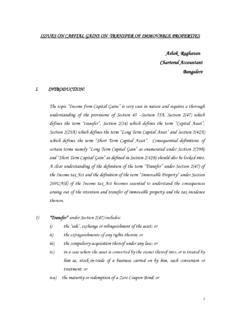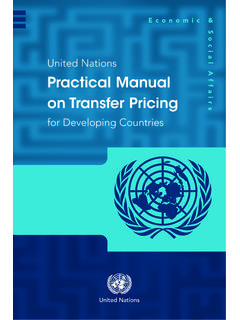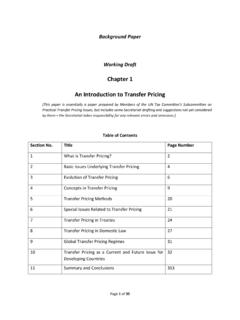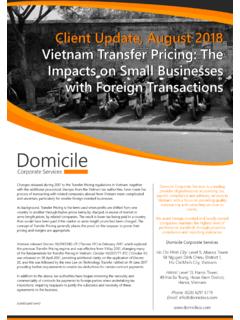Transcription of Transfer Pricing Methods Transactional Net …
1 Date1 Transfer PricingMethodsTransactionalNet MarginMethodPresented by:Suchint MajmudarNovember2009 PricewaterhouseCoopersNovember 2009 Slide2 AgendaTransfer Pricing Methods Introduction Transactional Net margin Method TNMM Comparable Profits Method CPM Date2 PricewaterhouseCoopersNovember 2009 Slide3 Most Appropriate Method OECD advocates the use of Traditionaltransaction Methods (CUP, RPM andCPM) over Transactional profitmethods (PSM and TNMM) [ChapterIII, ] Flexibility granted to taxpayer forselection of Most Appropriate Method No preference for any particularmethod under Indian Transfer pricinglawTransfer Pricing MethodsPricewaterhouseCoopersNovember 2009 Slide4 Selection of Most Appropriate Method [Rule 10C(2)] Factors determining Most Appropriate Method-nature and class of international transaction-class of associated enterprises and functions performed-availability and reliability of data-degree of comparability-extent and reliability of adjustments-nature, extent and reliability of assumptionsTransfer Pricing MethodsDate3 PricewaterhouseCoopersNovember 2009 Slide5 Traditional transaction Methods -Comparable Uncontrolled Price method (CUP)-Resale Price method (RPM)-Cost Plus method (CPM) Transaction profit Methods -Profit Split Method (PSM)- Transactional Net margin Method (TNMM)
2 Any other method that may be prescribed by the CBDTT ransfer Pricing MethodsPricewaterhouseCoopersNovember 2009 Slide6 Transactional Profit Methods OECD Discussion Draft Use of more than one Method-Use of a Transactional profit method in conjunction with atraditional transaction method-Use of a sanity check to test the plausibility of theoutcome of a primary methodTransfer Pricing Methods Review of Transactional Profit Methods -Status as method of last resort-Proposed amendments to TP GuidelinesDate4 PricewaterhouseCoopersNovember 2009 Slide7 TNMMT ransfer Pricing Methods Identify net profit margin realized by the enterprise from aninternational transactionwith regard to an appropriate base Identify net profit margin from a comparable uncontrolledtransaction or a number of such transactions having regard tothe same base Adjust for differences that could affect net profit in the openmarket Adjusted net profit used for establishing Arm s Length PricePricewaterhouseCoopersNovember 2009 Slide8 Application of TNMMT ransfer Pricing MethodsGP40,000 BIndependent ,250GP33, ,000OP3,750 Turnover 75,000 AAE DistributorTNMM(OP/Sales)= 5%Turnover 100,000TP60,000OP5, , 2009 Slide9 Application of TNMMT ransfer Pricing Methods Typical transactions where the TNMM may be used :-Provision of services-Distribution of finished products where RPM cannot beadequately applied or in case of a full-fledged distributor- Transfer of semi finished goods Inapplicability of all other Methods residuary methodPricewaterhouseCoopersNovember 2009 Slide10 Application of TNMMM arketing &management feesat Cost Plus + 6%-Rs.
3 25 crsThird PartyXYZ USXYZ IndiaContract value :Third party XYZ USRs. 100 crsXYZ India-XYZ USALP satisfied [proviso toSection 92C(2)]TNMM(AE is tested party :Comparables margin = s margin = 6%)Contract value :XYZ US XYZI ndiaRs. 100 crsDate6 PricewaterhouseCoopersNovember 2009 Slide11 Strengths and Weakness of TNMMT ransfer Pricing Methods Strengths:-less affected by Transactional differences-more tolerant to some functional differences-classification of expenses in the gross margin frequentlymakes it difficult to evaluate the comparability of grossmargins; the use of net margins may avoid the problem-Being a one-sided method, it is required to examine thefinancial indicator of the tested party alone Weaknesses:-net margin can be influenced by some factors that either donot have an effect, or have a less substantial or direct effect-these aspects may make accurate and reliabledeterminations of arm's length net margins difficultPricewaterhouseCoopersNovember 2009 Slide12 Some Pricing Methods Aggregation of transactions Loss situations Choice of PLI Startup companies.
4 Business Strategies Adjustment to net profit for calculating operating profit Percentage of AE transaction to total revenue/costs Preliminary/Pre-operative expenses Pass through costsDate7 PricewaterhouseCoopersNovember 2009 Slide13 Case LawsTransfer Pricing Methods Development Consultants Pvt Ltd Tested Party and choice of method Star India Distinct and separate activities to be considered individually Schefeneckar Motherson Cash Profit margin as PLI Morgan Stanley Use of TNMM as most appropriate method UCB India Inappropriate aggregation of transactions-TNMM analysis attransaction level Honeywell Automation-Only those items of income/expenses havingnexus with profit/loss should be considered for comparability purposes Skoda Auto Economic adjustments to be made to results of tested partyand comparables for differences in functional profilesPricewaterhouseCoopersNovember 2009 Slide14 Summary of MethodsMethodsComparabilityRequirementsA pproachRemarksCUPVery HighPrices are benchmarkedVery difficult to apply asvery high degree ofcomparability requiredRPMHighGross Profit margins arebenchmarkedDifficult to apply as highdegree of comparabilityrequiredCPMHighGross Profit margins arebenchmarkedDifficult to apply as highdegree of comparabilityrequiredPSMM ediumOperating Profit marginsare benchmarkedComplex Method,sparingly usedTNMMM ediumOperating Profit marginsare benchmarkedMost commonly usedmethodTransfer Pricing MethodsDate8 PricewaterhouseCoopersNovember 2009 Slide15 Each method, with the exception of the CUP method,examines a profit level indicator (PLI) relevant to the methodof analysis Specified financial ratio of the tested party is compared to theresults of independent, functionally comparable companiesChoice of Profit Level Indicators (PLIs)
5 Transfer Pricing MethodsPricewaterhouseCoopersNovember 2009 Slide16 Profit Level Indicator (PLI) and MethodsTransfer Pricing MethodsRPMGP/Sales = GMCPMGP/COPTNMMOP/SalesOP/TCBerry Ratio = GP/OpexOP/VAE {Berry Ratio = 1+ (OP/VAE)}OP/CE or OP/AssetsCash Profit MarginDate9 PricewaterhouseCoopersNovember 2009 Slide17 Choice of Profit Level Indicators (PLIs)MethodPLIF ormulaeTypically used forRPMG ross marginGross Profit/SalesDistributorCost PlusGross cost plusGross Profit/COGSM anufacturer/Service providerFull CostPlus/TNMMNet/Full cost plus(Return on totalcosts)Operating profit/Total costs(Total costs = COGS + OPEX)Manufacturer/Service providerTNMM/PSMO perating marginOperating Profit/Net sales or netturnoverManufacturer/Distributor/Serv iceproviderTNMM/PSMROAO perating Profit/OperatingassetsManufacturer/Distr ibutor/ServiceproviderTNMM/PSMROCEO perating Profit/Total assets Current LiabilitiesManufacturer/Distributor/Serv iceProviderTransfer Pricing MethodsPricewaterhouseCoopersNovember 2009 Slide18 Comparable Profits Method Reg.
6 Read with Reg. an arm slength return for the controlled Transfer of tangible propertybased on profit level indicators ( PLIs ) of uncontrolled partiesperforming activities similar to those of the controlled testedparty. Looks at the party that is the least complex in terms offunctions, risks, and intangibles owned ( tested party ). The Comparable Profits Method is most commonly used withPLIs that are based on operating Property MethodsDate10 PricewaterhouseCoopersNovember 2009 Slide19 Comparable Profits MethodSpecified PLIs Return on assets (return on capital employed); Operating margin ; Berry ratio (GP/OE); orOther appropriate financial ratios where the denominator doesnot reflect controlled transactions. Cannot use operating margin if selling to related parties(controlled sales in denominator). Cannot use GP/COGS or OI/TC if buying from related parties(controlled costs in denominator).Tangible Property MethodsPricewaterhouseCoopersNovember 2009 Slide20 Comparable Profits MethodAdjustments required if material, identifiable differences existbetween the unrelated and related transactions.
7 One type of adjustment is an asset intensity, balance sheet, or working capital adjustment. This adjustment is performedwhen a CPM is used, either by itself or as part of anothermethod such as a residual profit split. Adjustments are fordifferences in A/R, A/P, and inventory. Other adjustments include PP&E adjustments and SG& CPM is the most commonly utilized method to test anddocument the arm s length nature of a tangible propertyintercompany Property MethodsDate11 PricewaterhouseCoopersNovember 2009 Slide21 Comparable Profits Method Encourages segmentation of financials. Discourages use of industry average. Discourages analyzing company-wide profitability when there isa distinct differences between lines of business. Proper application of CPM under regulations is consistentwith Transactional Net margin Method (TNMM) under OECDG uidelines (assumes comparable transactions arecomparables only transactions).Tangible Property MethodsPricewaterhouseCoopersNovember 2009 Slide22 Comparable Profits Method The choice of tested party can reflect a choice about how toallocate risk.
8 Assigning a party only a routine return implies viewing thatparty as a mere service provider; a profit split, in contrast,implies viewing that party as a risk-taking entrepreneur or jointventure partner. Normally, the parties own definition of their relationship shouldbe accepted unless it is inconsistent with their conduct and theeconomic substance of the Property MethodsDate12 PricewaterhouseCoopersNovember 2009 Slide23 Comparable Profits MethodConsider a manufacturer selling to a controlled distributor. Testing only the distributor (for example, using a CPM with anoperating margin PLI) assigns the distributor a particular profitrange. The distributor must then earn a profit within that range withoutregard to the system profit ( , the combined profit frommanufacturing and distribution).Tangible Property MethodsPricewaterhouseCoopersNovember 2009 Slide24 Comparable Profits Method Thus, the distributor might be guaranteed a certain positive profit level evenwhen the manufacturer is sustaining substantial losses and the systemprofit is negative.
9 This situation has been referred to as profit creation since it assigns profitto one party despite an overall loss. In particular cases this result may correctly reflect the relative risk; a routinedistributor may be entitled to a profit when system profit is negative. In other cases, a routine distributor may be willing to bear losses for a shortperiod of time if the industry is in a downturn. However, in some cases one could argue for a sharing of risk if bothparties make value-added contributions to the transaction. This may callfor the profit split approach in which both parties are Property MethodsDate13 PricewaterhouseCoopersNovember 2009 Slide25 Comparable Profits MethodReg. In general, determine whether Pricing is arm slength indirectly, by seeing if a controlled taxpayer (the testedparty ) earns profits similar to those earned by comparablecompanies that engage in similar business activities undersimilar circumstancesComparability of functions more important than specific productCompare profit level indicators ( PLIs ), such as operatingmargin, return on assets, Pricing Methods for Intangible PropertyPricewaterhouseCoopersNovember 2009 Slide26 Comparable Profits Method For intangibles, tested party would generally be licensee If licensee s profits are lower (higher) than those ofcomparable companies (after adjustment for royalties paid forthe use of the intangible in question), the implication is that thelicensee is paying too high (too low) a royalty for use of theintangible.
10 What if comparables own or license valuable intangibles thatincrease profitability-Adjustments? Transfer Pricing Methods for Intangible PropertyDate14 PricewaterhouseCoopersNovember 2009 Slide27 Comparable Profits Method Validate royalty rate by comparing post-royalty profit tooperating profit earned by similar of comparables-Choice of Profit Level IndicatorsTransfer Pricing Methods for Intangible PropertyPricewaterhouseCoopersNovember 2009 Slide28 Comments: Comparable Profits Method Comparable Profits Method range can be wide Comparable companies typically own intangibles, whereas tested party is typically the licensee. Implicitly assumes all other internal prices are arm s length(purchase of components, sale of finished products, servicefees, etc.) Transfer Pricing Methods for Intangible PropertyDate15 PricewaterhouseCoopersNovember 2009 Slide29 Temporary Regulations: Comparable Profits Method Treas. Reg. (f) General principles set forth in Treas.
